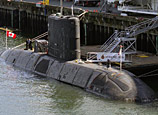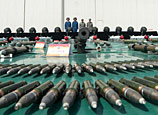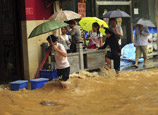
ROME, April 27 (Xinhua) -- Italy's newly nominated Prime Minister Enrico Letta got to work quickly on Saturday unveiling a new cabinet full of fresh faces, including more women than ever and the country's first ever non-white minister.
One name conspicuous in his absence from the new cabinet is three-time premier and media mogul Silvio Berlusconi. Speculation started swirling Friday that controversial Berlusconi would be appointed to a key ministerial post, possibly even as finance minister. But Berlusconi said Saturday he did not wish to be a minister, but that he would push for members of his party to be named to ministerial posts.
That indeed happened: Angelino Alfano, the head of Berlusconi's party, will be deputy prime minister and the interior minister.
Other key appointees include former European Commissioner Emma Bonino as foreign minister and Fabrizio Saccomanni, deputy head of the Bank of Italy, as finance minister.
Enrico Giovanni, the head of Italy's National Statistics Institute (ISTAT), will be labor minister. Chiara Carrozza, an expert on robotics, will be minister of education, while banker Flavio Zanonato will be minister of industry and Andrea Orlando, a former spokesman for Letta's center-left party, will be minister of environment.
The cabinet includes one high-profile from the outgoing technocrat government of Mario Monti will be Enzo Moavero Milanesi, who will stay on as minister for European affairs, while Cecile Kyenge, who was born in the Democratic Republic of Congo, will be the minister for integration -- the first non-white minister ever in Italy.
The cabinet is the most diverse Italy has seen -- in terms of gender (seven of 21 minister are women), race, and, most likely, in terms of party affiliation as well -- and is also the youngest group of ministers in recent memory. That is a fitting characteristic for 46-year-old Letta, Italy's youngest prime minister since 1954.
Nearly half the cabinet comes from Letta's own center-left coalition, but with four different political parties represented, plus three independents, the group will have to draw on its wide array of political bases to confront the obstacles the new government faces.
Among the new government's biggest challenges will be finding ways to continue paying down debt while jump starting the slow-growing Italian economy, and pushing through much-needed electoral reforms that would help avert another protracted government crisis that resulted in two months passing between Italy's Feb. 24-25 election and Wednesday, when President Giorgio Napolitano appointed Letta prime minister designate.
Letta is expected to be sworn in on Sunday, but won't actually start governing until the government passes a confidence vote in parliament.
Despite the economic and political challenges on the horizon, the government's biggest test may be how it navigates the diverse priorities of the cobbled-together coalition Letta is heading.
"It's not at all clear how they will make policy decisions, and with all these different parties and political philosophies involved," said Enrico Cigliani, political analyst with investment banker Hildebrandt and Ferrar. "Every major decision will be a potential battle."
For now at least, observers are looking past that, with markets reacting positively and optimism among the members of the new government.
"I hope this government can get to work quickly and in the spirit of cooperation, without prejudice or conflict," Napolitano said when the government was unveiled.
















 Heavy rain affects traffic in S China
Heavy rain affects traffic in S China


![]()
